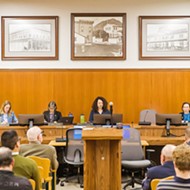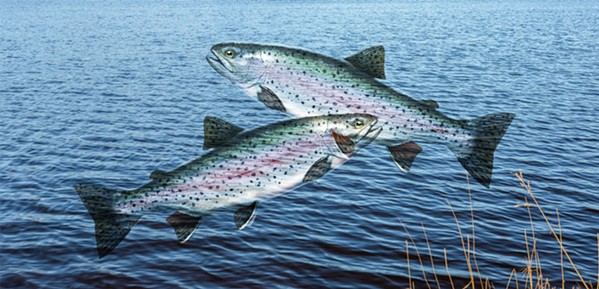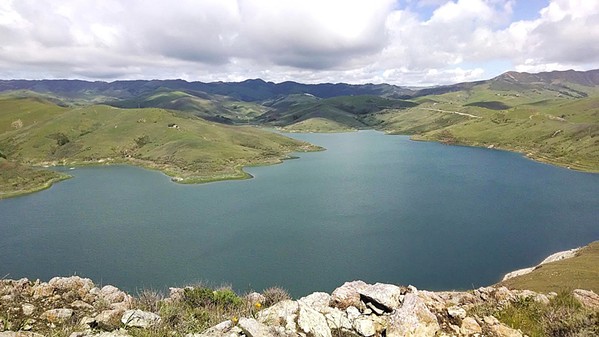Fish flop: Environmental groups allege that SLO County isn't doing enough to help steelhead populations succeed in Arroyo Grande Creek
By Samantha Herrera[
{
"name": "Newsletter Promo",
"id": "NewsletterPromo",
"class": "inlineCenter",
"insertPoint": "4",
"component": "15264767",
"requiredCountToDisplay": "0"
},
{
"name": "Ad - Medium Rectangle CC01 - 300x250 - Inline Content",
"class": "inlineCenter",
"insertPoint": "8",
"component": "15582119",
"requiredCountToDisplay": "12"
},{
"name": "Ad - Medium Rectangle LC01 - 300x250 - Inline Content",
"class": "inlineCenter",
"insertPoint": "18",
"component": "15582122",
"requiredCountToDisplay": "22"
},{
"name": "Ad - Medium Rectangle 9 - 300x250 - Inline Content",
"class": "inlineCenter",
"insertPoint": "28",
"component": "15582121",
"requiredCountToDisplay": "32"
}]
Four environmental organizations recently teamed up to sue San Luis Obispo County over Lopez Dam and what it's not doing for the endangered steelhead trout.
"Lopez Dam is a complete barrier blocking SCCC [South-Central California Coast] steelhead migration to the majority of high-quality spawning, rearing, and refugia habitat above Lopez Lake," the lawsuit reads. "Moreover, the county releases insufficient flows from Lopez Dam to the mainstem Arroyo Grande Creek resulting in severely degraded spawning, rearing, and migration habitat downstream of the dam."
San Luis Obispo Coastkeeper, Los Padres ForestWatch, California Coastkeeper Alliance, and The Ecological Rights Foundation filed their lawsuit against the county on Aug. 13. It alleges that several species in the Arroyo Grande Creek watershed that are listed as endangered or threatened under the federal Endangered Species Act are in jeopardy because of the way the county manages Lopez Dam.
The lawsuit states that county infrastructure projects including the dam and Lopez Lake cause "significant harm" to SCCC steelhead trout, the California red-legged frog, the tidewater goby, and the Bell's vireo.
Listed as an endangered species since 1997 with the possibility of becoming extinct in the next 25 to 50 years, steelhead are a slimmer relative to rainbow trout with bright, silvery sheen, found primarily in California, Oregon, Washington, and Idaho.
When steelhead mature, they leave their freshwater homes and journey out to the ocean before coming back to streams to lay eggs. Unlike other fish species, they don't die after one breeding trip. Instead, they tend to make several journeys throughout their lifetime.
The lawsuit claims that the county failed to release enough water from Lopez Dam to create healthy steelhead habitat in Arroyo Grande Creek, alleging that it violated California Fish and Game Code, section 5937, "which requires the owner of any dam to allow sufficient water to pass over, around, or through the dam, to keep in good condition all fish that reside below the dam." The way the county manages Lopez Dam and "other instream infrastructure" in Arroyo Grande Creek "prohibits steelhead migration upstream and downstream," the lawsuit added.
National Oceanic and Atmospheric Administration (NOAA) Fisheries Recovery Coordinator for SCCC Steelhead Mark Capelli told New Times that the current size of the steelhead populations in the county is unknown due to a lack of countywide monitoring.
"Some populations in the northern portion of the county are relatively robust, but vary considerably from year to year," he said. "The populations in the southern part of the county are more heavily impacted by development, and in the case of Arroyo Grande Creek by the Lopez Dam."
According to a NOAA Fisheries' 2023 five-year review of steelhead, within the previous five years, climate change had significantly impacted both steelhead and West Coast salmon due to degraded fish habitats, reduced summer flows, and warming water temperatures. As a result of the area's record-breaking drought from 2012 through 2017, NOAA found that prolonged closure of river mouths meant fewer opportunities for steelhead to enter coastal watersheds and reach upstream spawning and rearing habitat.
"A series of marine heatwaves have also reduced steelhead ocean survival and growth in the North Pacific Ocean. They increase algal and diatom blooms that can affect the productivity of steelhead prey or shift the species to less suitable prey," NOAA states. "Increasing ocean acidification and projected changes in coastal upwelling may undermine the growth and maturation of steelhead in the ocean. It could also reduce the size and condition of steelhead returning to their freshwater habitats to reproduce."
Capelli said that some of the most important recovery actions include controlling sediment buildup and runoff in watersheds from urban and agricultural land uses, restoring estuary functions, removing or modifying fish passage barriers, and controlling or eliminating introduced exotic species.
Many entities, including local and state governments, have been actively engaging in trying to recover the steelhead population in South Central California, Capelli said.
"The county of San Luis Obispo has been working on a Habitat Conservation Plan for Arroyo Grande Creek, and the California Department of Parks and Recreation does annual monitoring in the lower Arroyo Grande Creek," he said. "Proposed changes to the California Department of Fish and Wildlife's Fisheries Restoration Grant Program should generate more successful grant proposals for San Luis Obispo County next year."
The county's Habitat Conservation Plans provide a framework for people and agencies to complete projects while conserving at-risk plant and animal species.
SLO County officials told New Times that it wouldn't comment on pending litigation but did share a 10-page letter with New Times responding to the lawsuit, which claims that steelhead numbers were artificially propped up in Arroyo Grande Creek by the California Department of Fish and Wildlife as early as the 1940s, decades before Lopez Dam was built in 1969.
"Steelhead numbers in Arroyo Grande Creek saw a sharp decline, eventually reaching an estimate of zero in 1960," the response reads. "This history demonstrates that the [SCCC] steelhead's population dynamics are affected by a combination of natural and anthropogenic processes that predate the project by a number of decades."
The letter states that the county has implemented projects to avoid steelhead habitat impacts, including creating the Arroyo Grande Creek Watershed Management Program (WMP) that identifies critical issues affecting steelhead habitat.
"The WMP also created a riparian corridor to provide shade and keep water temperatures cool for steelhead. In 2013, the county completed the Rodriguez Bridge Waterline Crossing Fish Passage Improvements, which included the installation of a 250-foot roughened channel to conditions conducive to fish passage near the Rodriguez Bridge," the letter reads. "The county has also secured funding and partnered with Creek Lands Conservation to modify the Arroyo Grande stream gauge to improve fish passage."
The county says that it's doing its part to keep the fish below Lopez Dam in good condition.
"With respect to the Lopez Dam, county operations are keeping the SCCC steelhead and red-legged frog in good condition while balancing the needs of other users in the watershed," the letter states. Δ
Reach Staff Writer Samantha Herrera at [email protected].
Latest in News
Readers also liked…
-

When the levee breaks: Oceano residents, county officials walk a tightrope of regulations to manage Arroyo Grande Creek, which some say led to the levee's failure in January
May 18, 2023 -

Cal Poly report highlights offshore wind's potential to spur green energy transition
Jun 8, 2023 -

Cal Poly students demand rent control, accountability for substandard housing from SLO City Council
Jun 22, 2023










